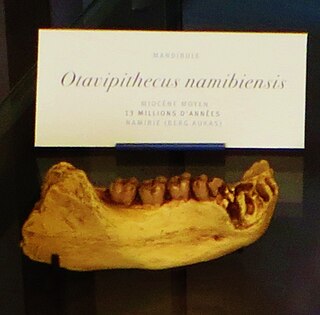Related Research Articles

Thiomargarita namibiensis is a Gram-negative coccoid Proteobacterium, found in the ocean sediments of the continental shelf of Namibia. It is the largest bacterium ever discovered, as a rule 0.1–0.3 mm (100–300 μm) in diameter, but sometimes attaining 0.75 mm (750 μm). Cells of Thiomargarita namibiensis are large enough to be visible to the naked eye. Although the species holds the record for the largest known bacterium, Epulopiscium fishelsoni – previously discovered in the gut of surgeonfish – grows slightly longer, but narrower.

The Thiotrichales are an order of Proteobacteria, including Thiomargarita namibiensis, the largest known bacterium.
Lachenalia namibiensis is a species of plant that is endemic to Namibia. Its natural habitat is cold desert.

Dryopithecini is an extinct tribe of Eurasian and African great apes that are believed to be close to the ancestry of gorillas, chimpanzees and humans. Members of this tribe are known as dryopithecines.
Hypotia namibiensis is a species of snout moth in the genus Hypotia. It was described by Patrice J.A. Leraut in 2007 and is known from Namibia, from which its species epithet is derived.
Schrankia namibiensis is a species of moth of the family Erebidae first described by Hermann Heinrich Hacker in 2004. It is found in Namibia.
Theocridini is a tribe of longhorn beetles of the subfamily Lamiinae. It was described by Thomson in 1858.
Planodema is a genus of longhorn beetles of the subfamily Lamiinae, containing the following species:
Gordonia namibiensis is a bacterium from the genus of Gordonia which has been isolated from soil from Kalahari in Namibia. Gordonia namibiensis metabolises nitrile.
Planodema flavovittata is a species of beetle in the family Cerambycidae. It was described by Stephan von Breuning in 1947.
Planodema freyi is a species of beetle in the family Cerambycidae. It was described by Stephan von Breuning in 1955.
Planodema similis is a species of beetle in the family Cerambycidae. It was described by Stephan von Breuning in 1958.
Planodema congoensis is a species of beetle in the family Cerambycidae. It was described by Stephan von Breuning in 1942.
Planodema griseolineata is a species of beetle in the family Cerambycidae. It was described by Stephan von Breuning in 1938, originally under the genus Docus.
Planodema leonensis is a species of beetle in the family Cerambycidae. It was described by Stephan von Breuning in 1936.
Planodema nigra is a species of beetle in the family Cerambycidae. It was described by Stephan von Breuning in 1942.
Planodema flavosparsa is a species of beetle in the family Cerambycidae. It was described by Per Olof Christopher Aurivillius in 1910.
Planodema granulata is a species of beetle in the family Cerambycidae. It was described by Per Olof Christopher Aurivillius in 1928. It is known from South Africa, Somalia, and Zimbabwe.

Otavipithecus namibiensis is an extinct species of ape from the Miocene of Namibia. The fossils were discovered at the Berg Aukas mines in the foothills of the Otavi mountains, hence the generic name. The species was described in 1992 by Glenn Conroy and colleagues, and was at the time the only non-hominin fossil ape known from southern Africa. The fossils consist of part of the lower jawbone with molars, a partial frontal bone, a heavily damaged ulna, one vertebra and a partial finger bone.
Homalocnemis is a genus of flies which is placed in a family of its own, the Homalocnemiidae. There are about seven species in the genus found in the Afrotropical, Neotropical, and Australasian regions, suggestive of a Gondwanan origin. The genus was formerly considered a primitive empidoid and placed variously in the Hybotidae or in the empidid subfamily Brachystomatinae. They are recognized by their wing venation which includes a long anal cell and a long basal segment of the antennal style.
References
- ↑ BioLib.cz - Planodema namibiensis. Retrieved on 8 September 2014.